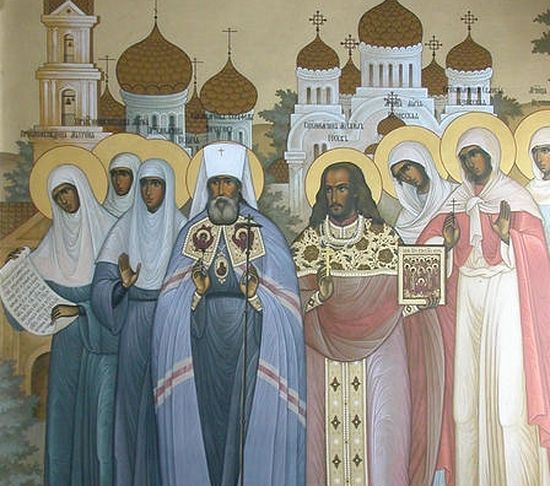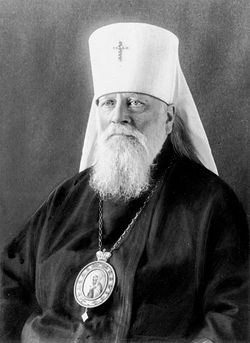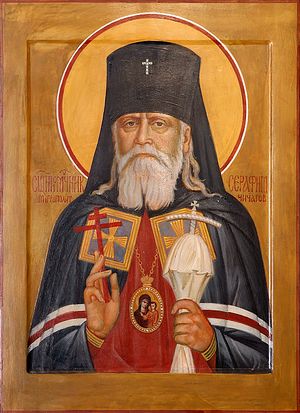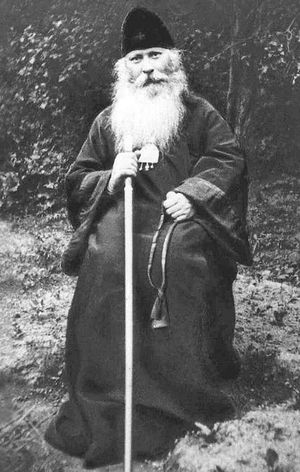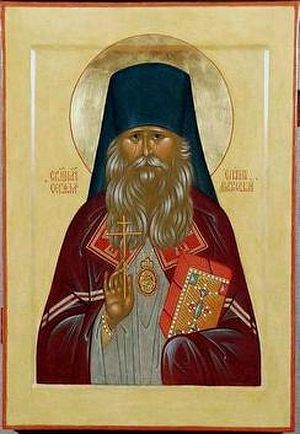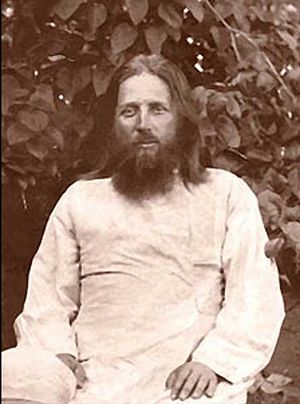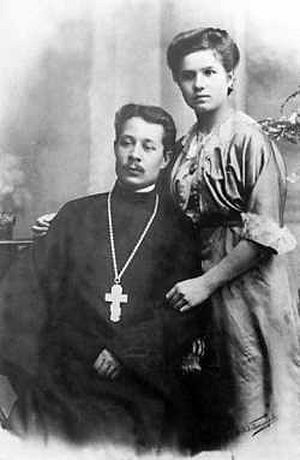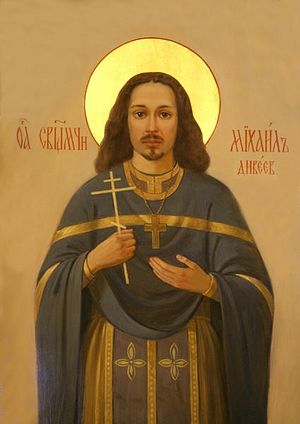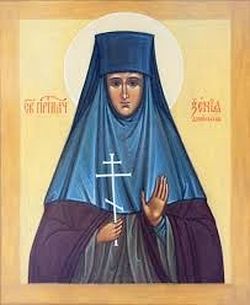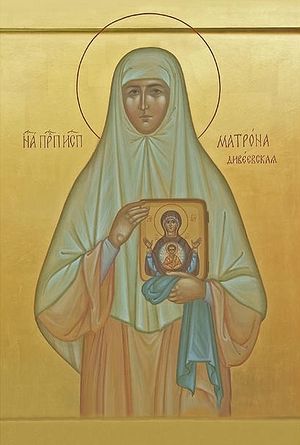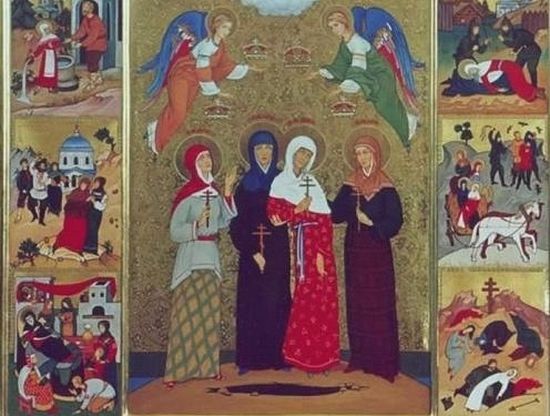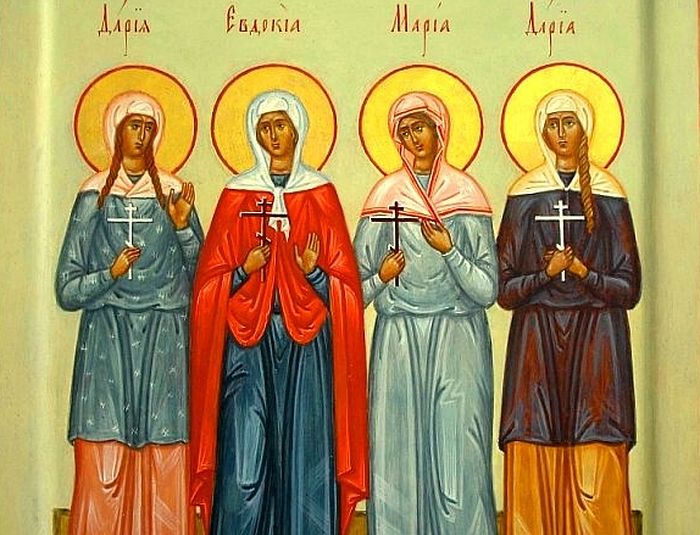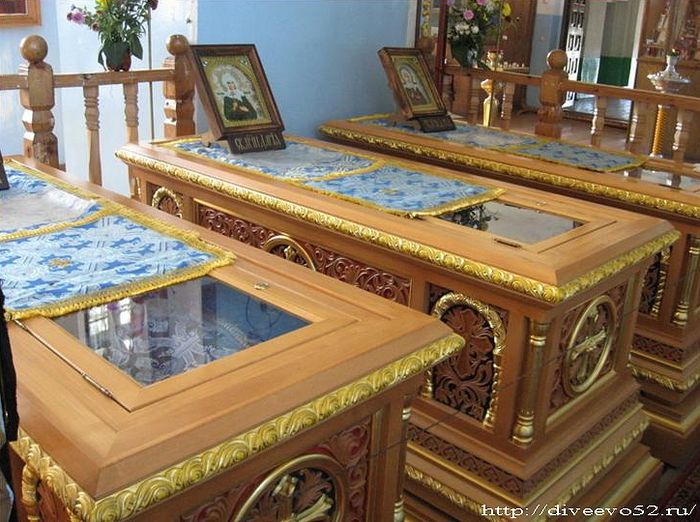A metropolitan, a bishop, rural priests, Diveyevo nuns, a “fool-for-Christ” and her cell attendants… They suffered for Christ in different ways, but all stood firmly in their faith. And it was Diveyevo Convent that connected all of them.
After the Revolution of 1917 unprecedented of anti-religious persecutions began in Russia. The St. Seraphim-Diveyevo Convent, among many other monasteries, was affected by them.
In 1919, Diveyevo was turned into a labor artel [a cooperative association]. A needlework artel existed until the convent was closed. Sketes and farmsteads were confiscated and looted, harvests were taken away from the sisters by the authorities, so the nuns had to buy grain and potatoes with their own money for sowing. The sisters were not allowed to use water from the pumping-works and they had to walk to the river for water. But at the convent itself everyday monastic life continued, churches were not closed yet and services were celebrated.
In 1920 the holy relics of St. Seraphim of Sarov were publicly opened and several years later transferred to a museum of atheism for desecration. Thus Father Seraphim even by his flesh shared in the suffering of the whole Church.
In 1927 the meaning of a famous prophecy of St. Seraphim became clear: “The time will come when my orphans, like peas, will be cast through the Nativity gates.” On the feast of the Nativity of Theotokos the atheistic Soviet authorities started dissolving the community and within a week the convent was closed. In his festal sermon at the early morning Liturgy Bishop Seraphim (Zvezdinsky) of Dmitrov said, addressing himself to the sisters: “The convent is being closed, but you will remain bound to your monastic vows. Now the [bitter] cup is being given to each of you—and will you be able to drink it worthily? Up to now you have burned as one large candle, but henceforth you will be separated into smaller ‘individual’ candles. You need to preserve this fire.”
On the same night, Bishop Seraphim and Archbishop Zinovy (Drozdov) of Tambov (+ 1942; a hieromartyr) who then lived in Diveyevo, together with the abbess, the clergy and senior sisters were arrested, while the rest of the nuns scattered all over the neighborhood. Most of them settled in neighboring villages, including the very village of Diveyevo, and the abbess (after the dispensation) with some of the sisters moved to the town of Murom. For the majority of them it was the beginning of the path of confession of Christ—prisons, exiles and hard labor awaited many of them…
Among the saints who were canonized as the New Martyrs and Confessors of the Russian Church, six saints from among the convent’s nuns and clergy are especially venerated at Diveyevo along with two archpastors, whose lives were by providence inseparably linked with the convent, and the women martyrs who suffered in the Suvorovo village not far from Diveyevo.
All the New Martyrs and Confessors of Diveyevo are commemorated on the following days: the Synaxis of All Saints of Diveyevo (June 14/27), the Synaxis of the New Martyrs and Confessors of the Russian Church (January 25/February 7, if this day falls on a Sunday, otherwise—the first Sunday after January 25/February 7), and the Synaxis of the Saints of Nizhny Novgorod (the second Sunday of September).
Hieromartyr Seraphim (Chichagov), Metropolitan of Leningrad and Gdov
(Commemorated: November 28/December 11)
Hieromartyr Seraphim (secular name: Leonid Mikhailovich Chichagov) was born on January 9, 1856, in St. Petersburg into one of the most famous noble families of the Kostroma province.
After a meeting with St. John of Kronstadt in 1878 all important decisions in the life of the future holy hierarch were made with this saint’s blessing. Soon after his ordination as a priest (February 28, 1893) young Father Leonid Chichagov wanted to visit Sarov Monastery (or “Pustyn”—“Hermitage”)—the site of the spiritual labors of St. Seraphim, who then was not yet canonized. He spent several days there, unceasingly praying and visiting all the places where Elder Seraphim had lived.
After Sarov Fr. Leonid arrived to Diveyevo Convent where he visited the holy eldress Pasha (Parasceva), a “fool-for-Christ”, who suddenly passed on to him the instruction of St. Seraphim to compile A Chronicle of the St. Seraphim-Diveyevo Convent. Relying on the help of Father Seraphim, Fr. Leonid ventured to publish this work, which provided a full picture of the life and podvigs [spiritual labors] of the venerable man and his meaning for the people’s religious life, and to present it to the emperor—thus the will of the holy elder would be fulfilled.
After the repose of his spouse Fr. Leonid entrusted his four daughters to the care of authorized persons and in the summer of 1898 was tonsured a monk with the name Seraphim. He often visited Diveyevo. Feeling continuous support of the venerable man, Archimandrite Seraphim spoke at the Holy Synod and put forward the proposal to canonize the wonderworker of Sarov. In August of 1902, at the emperor’s insistence, the commission which included Archimandrite Seraphim conducted a preliminary examination of the saint’s relics. Fr. Seraphim was charged with most of the organizational events related to the canonization. The celebrations took place in Sarov on July 17-19, 1903.
The Lord preordained a new form of Church ministry for Fr. Seraphim. On April 28, 1905, he was consecrated Bishop of Sukhumi at the Moscow Kremlin’s Dormition Cathedral. From that time and till the very end of his life Hieromartyr Seraphim’s archpastoral ministry was inseparably linked with his outstanding courage in standing up for the purity of the Orthodox faith and the unity of the Russian Church. Dioceses which required special labors were entrusted to his archpastoral care. From 1906 he served in the Diocese of Orel, from 1908 in the Diocese of Chisinau, from 1912 in the Diocese of Tver.
In March 1917 the hierarch openly expressed his negative attitude towards the changes that had occurred in Russia. On December 28 the Religious Confessions Department of the Tver Province’s Executive Committee issued a directive to expel the hierarch from the Tver province. His Holiness Patriarch Tikhon appointed him Bishop of Warsaw and Vistula—a diocese on the territory of Poland that was free at that time from Bolshevik rule—but the civil war and the Polish-Soviet War that broke out soon made his departure for the diocese impossible.
On September 21, 1921, Archbishop Seraphim was arrested and put to Taganka prison. Several months later he was sent to Arkhangelsk. After about a year in exile Archbishop Seraphim returned to Moscow. In April 1924 he was arrested again; the State Political Management accused him of organizing the glorification of St. Seraphim of Sarov! In May, by the intercession of His Holiness Patriarch Tikhon, the hierarch was released but forced to leave Moscow. He spent three years at the Resurrection Convent of the Feodorovskaya Icon of the Mother of God near Shuya (now a monastery for men in the Ivanovo region).
Late in 1927 he left the convent to take part in the work of the Temporary Patriarchal Holy Synod. On February 23, 1928, St. Seraphim was elevated to the position of Metropolitan of Leningrad.
The metropolitan tried to gradually solve the main problem of the time of his ministry in that diocese—the healing of the schism associated with Metropolitan Joseph. In his sermons the saint explained the danger of the split for the canonical unity of the persecuted Russian Orthodox Church and himself entered into negotiations with leading representatives of the clergy among the followers of Metropolitan Joseph. On April 1, 1928, St. Seraphim blessed to offer up special prayers in all the city’s churches for reconciliation inside the Church.
In 1933 the seventy-seven-year-old metropolitan had to retire. He spent the final years of his life in two rooms of a country house at Udelnaya train station near St. Petersburg, writing his theological and ascetical works, devoting much time to prayer and preparing himself to meet his Christ.
In November 1937 the holy hierarch (who by that time was gravely ill) was carried out in a stretcher from his home and delivered to Taganks prison. On December 11, 1937, the saint was executed by a firing squad at Butovo firing range.
Hieromartyr Seraphim (Chichagov) was canonized at the Council of Bishops of the Russian Orthodox Church on February 18-23, 1997.
Hieromartyr Seraphim (Zvezdinsky), Bishop of Dmitrov
(Commemorated: August 13/26).
St. Seraphim (secular name: Nikolai Ivanovich Zvezdinsky) was born on April 7, 1883, to a family of Unified Faith Old Ritualists [a movement of Old Ritualists who recognized the hierarchy of the ROC]. In 1902 he developed an incurable illness but was miraculously healed due to prayers before an icon of St. Seraphim of Sarov, who was not yet canonized. This icon accompanied the future saint throughout his life.
On September 26, 1908, he was tonsured a monk with the name Seraphim after St. Seraphim of Sarov. On graduating from the Moscow Theological Academy he worked at some theological seminaries near Moscow. Then he was appointed abbot of Chudov Monastery.
In 1918, when representatives of the new authorities closed the Kremlin, Bishop Arseny (Zhadanovsky) and Archimandrite Seraphim left the Chudov Monastery. For one year and a half they found refuge at a monastic community in the forest near the Skete of St. Seraphim and the icon of the Mother of God “Of the Sign”, arranged for them by Schema-Abbess Fomar, a spiritual child of Seraphim (Zvezdinsky).
On January 3, 1920, Archimandrite Seraphim was consecrated bishop of Dmitrov by His Holiness Patriarch Tikhon. His archpastoral ministry was putting his love for Christ and people into practice.
On December 12, 1922, he was arrested for the first time. After interrogations the bishop was transferred from Lubyanka Prison to Butyrka Prison. Bishop Seraphim consoled those who were filled with despair, supporting them by prayer. Even there he celebrated Divine Liturgy, heard confessions of those who had never been to confession before, gave them Communion and encouraged them. He served a sentence of two years of exile in the Zyrian territory [now Komi], where he celebrated the Liturgy daily.
After the saint’s exile, he lived for some time at Moscow St. Daniel’s Monastery, and then at the Anosino Convent of Sts. Boris and Gleb [in the Istra district near Moscow). A year later he was summoned to Lubyanka and ordered to leave Moscow.
The hierarch was assigned to go either to Diveyevo or to Sarov for six months, and so he arrived at Diveyevo on July 17, 1926. He was allowed to serve the Liturgy at the lower (basement) Church of “The Healer of Sorrows” icon of the Mother of God under the upper Church of the Tikhvin icon. He had to start the early Liturgy at four in the morning in order to finish it before the beginning of the Liturgy at the upper church.
After services Bishop Seraphim used to walk around the Holy Canal of Theotokos with the prayer to the Mother of God, as St. Seraphim had instructed; he also would come to the saint’s “near hermitage”, which had been removed to Diveyevo from the forest of Sarov. Bishop Seraphim would spend winters in the rooms of Elena Motovilova in a building behind the Holy Canal. One day the Most Pure Virgin Herself appeared to him—the saint saw Her walking round the Canal.
In the autumn of 1927 representatives of the authorities announced the closure of Diveyevo Convent. On the night before September 22 the hierarch together with Bishop Zinovy, Abbess Alexandra, senior sisters and the clergy were arrested and confined to Arzamas Prison. On October 8 the bishops and the abbess were released, but several days later the hierarchs were suddenly summoned to Moscow. In order not to be a convenient tool of the Unified State Political Directorate, St. Seraphim filed a petition to Metropolitan Sergius that he (St. Seraphim) be retired.
Hieromartyr Seraphim had unshakeable faith and fortitude. He was an implacable opponent of the so-called “Renovation schism” and the clergy of “the Living Church.” At the same time, he showed apparent disapproval of Metropolitan Sergius’ policy. Neither creating a new schism nor joining the opposition led by Metropolitan Joseph, St. Seraphim (like his friend, Bishop Arseny) was among those who refused to remember Metropolitan Sergius at the Liturgy.
In April 1932 he was arrested again and sentenced to three years of exile in Kazakhstan, later he was transferred to Uralsk and then to Omsk. After the exile Bishop Seraphim took up residence in Ishim. There, on June 24, 1937, among other churchmen the saint was arrested again and sentenced to execution by firing squad. On August 26, the sentence was carried into effect.
Bishop-Martyr Seraphim (Zvezdinsky) was canonized among the Synaxis of the New Martyrs and Confessors of the Russian Church at the Jubilee Bishops’ Council in August 2000.
The Holy New Martyrs Yakov (James) (commemorated: December 16/29) and Mikhail
(Commemorated: November 7/20) Gusev
The brothers Yakov and Mikhail were sons of Archpriest Ioann Feofanovich Gusev from Diveyevo Convent, a descendant of Archpriest Vasily Sadovsky—the first priest to serve at the convent whom Father Seraphim entrusted with the care of “the Diveyevo orphans.”
Yakov Ivanovich was ordained a priest in 1911 and sent first to the Khudoshino village, and soon after that—to St. Nicholas Church of the Elizaryevo village, close to Diveyevo. Elizaryevo residents loved Fr. Yakov and his family very much; in particular, they liked his sermons which were short but heart-penetrating. In difficult times his house was full of relatives who were in need of shelter.
Mikhail Ivanovich studied medicine at Warsaw University and became a priest with his father’s blessing. He began to serve at Diveyevo after his ordination in 1913.
The Soviet Government was established in that district in February 1918, and in the spring of 1919 the land was reallotted. The land was divided per head and only among those who cultivated it. Priests as servers of “the religious cult” were deprived of their voting rights.
In 1927 on the eve of the Nativity of the Mother of God a policeman forbade sisters to ring the bells before the Vigil. Fr. Mikhail was preparing for the service. Wondering why the bells were not ringing, he came up to the bell-tower and at once was arrested. He was taken to Arzamas Prison. Two weeks later he was discharged and moved with his family to his brother’s house in Elizaryevo. The brothers together took care of the persecuted Diveyevo sisters and placed them in the houses of believers.
This is what Nun Seraphima of Diveyevo wrote of the brothers-priests: “Both of them were born near the convent; they loved the nuns as their own family and wished that many of us could live in Elizaryevo… Services in Elizaryevo were held only on Sundays and major feasts along with forty days’ prayers for the living and the dead; but Fr. Yakov served more frequently in order to comfort us. We read and sang in the choir on weekdays… They shared with us our sorrows concerning the convent’s hardships, supported us spiritually and even materially.” With time the priests gave their blessing to transfer the Diveyevo eldress, Maria Ivanovna (Fedina), a “fool-for-Christ”, from Puzo village.
Soon Fr. Mikhail was appointed rector of St. Nicholas Church in the Kulibaki village where there was a large metallurgical plant. The priest was kind-hearted, just, enjoyed the love and respect of his parishioners and neighbors, continued with his support of the Diveyevo sisters, and did not forget about the children of arrested clergymen.
Before his second arrest Fr. Mikhail was twice summoned to the People’s Commissariat of Internal Affairs (NKDV) and told to renounce his priesthood. On August 31, 1937, he was arrested and accused of organizing of “a counter-revolutionary Church-Fascist group.” Before his arrest the pastor left a note to his wife, saying, “Don’t cry, don’t grumble—this is inevitable. The Savior’s words have been fulfilled on us.” During the interrogation Fr. Mikhail flatly denied all the charges against him.
Archpriest Mikhail Gusev was executed by firing squad in Gorky [Nizhny Novgorod] on November 20, the day before his name day, the Synaxis of the Archangel Michael and All Other Bodiless Powers.
Fr. Yakov was constantly persecuted by the atheistic authorities. In 1930 he was arrested and taken into custody at Gorky Prison. His house was confiscated. In 1931 the pastor was arrested again and “dispossessed” as a kulak [a wealthy peasant]. Another arrest followed four years later. The priest was accused of inciting his parishioners to collect signatures “against converting the church into a granary.” On November 20, 1937 (the day of his brother’s execution), Fr. Yakov was arrested at the church, taken straight to Arzamas Prison and was not even allowed to call at his house. Like Fr. Mikhail, Fr. Yakov displayed dignity and courage during the interrogation, denying any charges.
On December 2 the sentence was announced: to execute him by firing squad and to confiscate his property. There is an entry in an abstract of the record: “Executed by a firing squad in Gorky on December 29, 1937.”
Fr. Mikhail was forty-seven years old, Fr. Yakov was fifty. The families of the martyred brothers did not know what became of them for long time; it was only in the 1950s that they received the false information that the brothers had died on account of an illness.
Priest-Martyrs Mikhail and Yakov of Diveyevo were canonized on December 6, 2001 and July 30, 2003 respectively.
Nun Martyrs Pelagia (commemorated: October 21/November 3) and Martha
(Commemorated: April 13/26) (Testova)
Sts. Martha and Pelagia were sisters. They were born into a poor peasant family in the village of Arga of the Tambov province. Both decided to devote their lives to the service of God. In 1901, at the age of fourteen, Pelagia who was the younger sister, joined Diveyevo Convent, and soon after that her elder sister followed her example.
At the end of summer 1919, when the convent was turned into a labor artel, it was suggested that some of the nuns be sent to help with the harvest on fields belonging to the Red Army officers’ families. The convent’s council rightly pointed out that the sisters were emaciated due to lack of food, couldn’t work in the fields, and besides, their own harvest was still not reaped. Novice Pelagia worked as a dressmaker and a mower, was a member of the council and “the manager of the convent’s work forces.” She tried to defend the sisters and refused to implement the requirements of a representative of the authorities. As a result she was arrested and sentenced to three years of imprisonment.
A commission was sent to Diveyevo Convent to examine “the counter-revolutionary activities” of the community but in the end it found the nuns innocent. The nuns were freed, and the convent’s council reinstated. The convent existed for another eight years, officially as an artel.
After the closure of the convent Sts. Pelagia and Martha lived at different churches, just as other Diveyevo sisters found shelter in the homes of believers. Novice Nun Martha made her home in the gatehouse attached to the church of the Razvilye village of the Bor district, and Novice Nun Pelagia at the church of the Vorobyevo village of the Arzamas district. The two saints never met again in their lifetime, though their life paths had many similarities from that moment on. The nuns, for the most part, read at the church and prayed. The faithful held the saintly sisters in high regard and often came to them, seeking their advice or asking to pray for them or their relatives. The faithful helped the nuns survive by sharing food and money with them.
Both nuns were arrested in November 1937 and accused of “counter-revolutionary agitation” and “anti-Soviet activity.” During interrogations they gave direct and clear responses and did not falsely accuse themselves. Three weeks later, on December 13 and 14 respectively, they were sentenced to eight years in the Karlag forced labor camp in Karaganda (Kazakhstan).
The new martyrs were not to meet again in this life: the camp was big, and their camp locations were different. It is unlikely that they knew that they were working almost side by side. In spite of the unbearable penal servitude and very painful diseases, the sisters toiled conscientiously and with great patience bore this cross for the Lord’s sake. Even the labor camp’s administration noted the good quality of the sisters’ work, the care of the tools, and performance of the labor norms.
The camp became the final abode in the life of each of the nuns, thus their love and faithfulness to Christ were tested for the last time. Novice Nun Martha lived in the labor camp for three years. Terribly exhausted by illnesses and hard work, she died of cardiac decompensation at the camp’s hospital on April 26, 1941, and was buried in the graveyard of the Spassky camp of Karlag. Sister Pelagia died of cancer at the camp’s hospital on November 3, 1944, and was interred in the camp’s cemetery near Zhartas village.
The name of Venerable Martyr Pelagia was included in the Synaxis of the New Martyrs and Confessors of the Russian Church on October 6, 2001, and that of Venerable Martyr Martha—on October 7, 2002.
Nun Martyr Xenia (Cherlina-Brailovskaya)
(Commemorated: September 2/15)
Xenia Cherlina-Brailovskaya was born in Kharkiv into a lower middle-class family. Until 1917 she was a nun of Diveyevo Convent and then started wandering. One of the investigation files reads: “Before the Revolution she was closely connected with Princess Olga Nikolaevna Romanova with whom she travelled to many monasteries.”
Following the Revolution and the plundering of Diveyevo Convent, St. Xenia moved to the Alexandro-Vorontsovskoye village of Tver province. In 1933 she was arrested and sentenced to eight years in corrective labor camps for “the participation in a counter-revolutionary monarchist organization.” She was sent to the Koktun-Kul office of the Karlag Karaganda camp, where she worked as a calf-tender.
In August of 1937 Nun Xenia was arrested on the camp’s territory on the basis of a denunciation: “Cherlina went to a panikhida [a memorial service] to pray for the fallen at the Cossacks’ graves. She said to inmates of the prison camp that ‘we, the people of God, should pray for the repose of the fallen soldiers, but shouldn’t listen to the antichrist’s, that is, the Soviet, propaganda. Now that our people are being tried, we all are standing before God and must endure everything, and then the Lord will help us’.” The indictment read: “[Xenia] was a member of a counter-revolutionary group which arranged illegal prayer meetings on knolls where they built a cross of stones, which is anti-Soviet propaganda; [she] went to pray at a panikhida for the fallen soldiers which is anti-revolutionary agitation and defeatism.”
The saintly nun did not admit her guilt. On September 10, 1937, she was sentenced to execution by shooting. Five days later the sentence was carried into effect.
Nun Xenia was canonized among the New Martyrs and Confessors of the Russian Church at the Jubilee Bishops’ Council of the Russian Orthodox Church in 2000.
Holy Confessor Matrona (Vlasova)
(Commemorated: October 25/November 7)
St. Matrona was born in 1889 in the village of Puzo of the Nizhny Novgorod province (now Suvorovo) into a peasant family. As a girl of six she was left an orphan and placed in the care of Saint Seraphim—Diveyevo Convent. Young Matrona displayed an aptitude for drawing so her obedience was icon-painting. The novice nun lived at the convent for thirty-two years in obedience and prayer until its closure in 1927.
Together with three other Diveyevo sisters she moved to the Kuzyatovo village of the Ardatov district. The nuns assisted at the church and made some money by needlework. In April 1933 they were arrested and charged with anti-Soviet agitation. On May 21 Novice Nun Matrona was sentenced to three years in the Dmitrov Camp of the Moscow region which was notorious for its very harsh conditions.
After serving her term St. Matrona settled at the church of the Verigino village in the Gorky district where she worked as a chorister, a church caretaker, and a cleaning woman. On November 10, 1937, the nun was arrested for the second time and accused of “the involvement in a counter-revolutionary Church-Fascist organization.” During the examination the saint refused to give evidence and pleaded not guilty.
Novice Nun Matrona was sentenced to ten years of labor at the Karlag camp where she worked as a cleaner in the hospital. The hospital administration noted her conscientious work and modest behavior. After her release she settled at the Vyezdnoye locality near Arzamas, where now one of the Diveyevo sketes is located. As before, her main occupation was serving in the church.
On October 19, 1949, the holy nun was arrested again on the basis of the materials relating to the old case (of 1937) and exiled to Kazakhstan. Matrona was charged with “hostile activities,” and there were even attempts to slander a priest of the Verigino village, but all the investigators’ efforts proved futile. The case even comprises the information that “the investigative file makes no mention of the individuals compromised by the evidence of the detainee Vlasova.”
Altogether the Venerable Confessor Matrona of Diveyevo spent seventeen years in camps. In 1954 her brother Andrei submitted a clemency petition on his sister’s behalf. The holy nun spent the final years of her life in her brother’s house in her native village of Puzo.
Sister Matrona was very humble and meek. She would pray the best part of a day. The church was closed, so the Diveyevo sisters performed their services at homes despite all the prohibitions and persecutions.
St. Matrona passed away peacefully on November 7, 1963. She was buried on the left of the graves of the Holy Martyrs Eudocia, Daria, Daria and Maria of Puzo. On October 6, 2001, by the decision of the Holy Synod Novice Nun Matrona (Vlasova) was canonized. Her relics were uncovered on September 5, 2007. Now they are kept at the Cathedral of the Kazan icon of the Mother of God at Diveyevo Convent.
The Holy Martyrs Eudocia (Shikova), Daria (Timolina), Daria (Siushinskaya) and Maria of Puzo
(Commemorated: August 5/18)
Eudocia (sometimes spelled Shikova) was born on February 11/24, 1856, in the Puzo village into a peasant family. Orphaned at an early age, the future saint was reared in the family of her uncle, a churchwarden. Dunya [a diminutive form of the name Eudocia] was very pious, visited many holy sites, including Sarov Monastery and Diveyevo Convent. From her youth Eudocia led a life of a “holy fool”; for example, she used to wear a warm shawl and a homespun coat all year round, enduring beating and jeers with great patience. At the age of twenty, Dunya was taken seriously ill and became bedridden for the rest of her life. Young maidens, “care-givers”, used to come to her and take care of her. Together with them the venerable woman founded something like a monastic community.
Eudocia had five close disciples. Three of them—Daria Timolina, Daria Siushinskaya and Maria—were martyred together with her, while two others gave an account of the life and martyrdom of these saints.
Blessed Eudocia led a strict ascetic life and taught her spiritual daughters to do the same. She took upon herself the spiritual podvig of “foolishness-for-Christ’s sake.” The Lord bestowed rich gifts upon Eudocia already in her lifetime, such as clairvoyance and healing. The saint liked to sing Church hymns together with her spiritual daughters and other visitors and prayed very much. The village residents who knew Eudocia venerated her as an eldress.
Martyr Daria Timolina came to Blessed Eudocia despite her parents’ opposition. Neither beating, nor threats, nor promising her in marriage to someone by her relatives against her will could compel the maiden to abandon her spiritual labors at Dunya’s. Over a period of twenty years Daria never left Dunya’s cell—she even did not go out to see her relatives and did not attend church (they were given Communion at home). Daria was a great faster and accepted everything from Dunya with joy, even when the latter scolded her. Daria’s spirit burned with the aspiration towards God. At the time of her martyrdom she was forty years old.
Holy Martyr Daria Siushinskaya practiced unceasing Jesus Prayer. When she still lived in the world, Daria would read through the Psalter while standing, without a break, every day. She was very meek. She lived at Dunya’s for three years. By the time of her martyrdom she reached the age of forty as well.
St. Maria was married early in life. But after a miraculous vision of St. Nicholas the Wonderworker who healed her from a malady Maria began wandering. It was at command of St. Nicholas that she came to Dunya. Maria served Dunya for seven years and was as obedient as an infant. Maria had left her beloved husband for God’s sake, and she revealed her name and surname to nobody lest her husband and other relatives should find her. During the last year she had a sharp pain in her leg and could hardly walk. Knowing that they would be killed, St. Maria (together with others) of her own free will came to share their mentor’s fate.
St. Eudocia and her cell-attendants were arrested in August 1919. Godless individuals took turns beating Dunya nonstop for more than one whole day. The atheists did not let anybody in. When the beating stopped, the saint talked the soldier into calling a priest. Two hours before their martyrdom, St. Eudocia and her faithful disciples confessed and took Communion.
Despite the austerity of the spiritual labors of Martyr Eudocia, despite her seeming strictness and exactingness, people felt deep affection for her and even tried to shield her from beating as she was being carried to the site of her execution.
The Lord glorified His saints by numerous miracles both on the day of their martyrdom and afterwards.
They were executed by a firing squad on August 18, 1919, and interred in the same grave.
In August 2000 Sts. Eudocia, Daria, Daria and Maria of Puzo were canonized in the Synaxis of the New Martyrs and Confessors of the Russian Church at the Jubilee Bishops’ Council. After the glorification the holy martyrs’ relics were elevated, and today they are enshrined at the Holy Dormition’s Church of the Suvorovo village. Numerous pilgrims and representatives of the clergy flock there on their feast day every year.
Troparion to the New Martyrs of Diveyevo, tone 5:
Today the Russian land rejoices in glorifying her New Martyrs that Diveyevo Convent brought forth, who in their faith, patience and meekness became like the first Christians, and now pray for the salvation of our souls.

